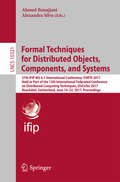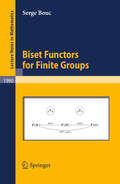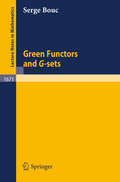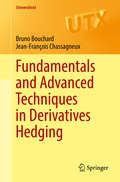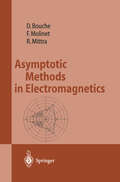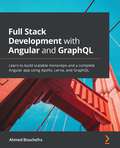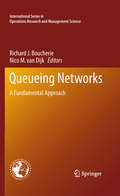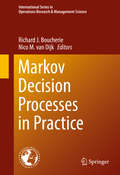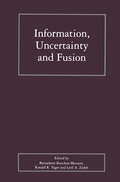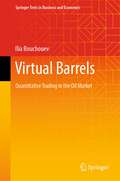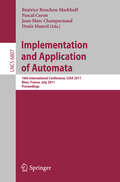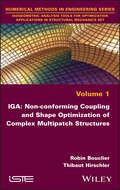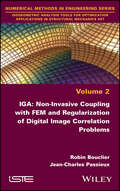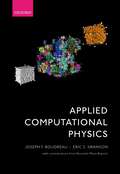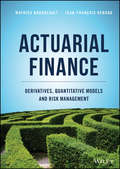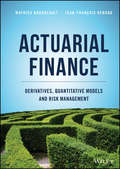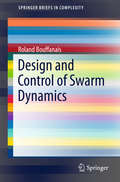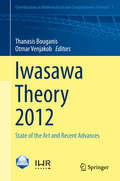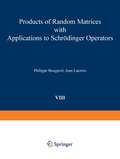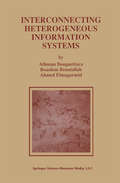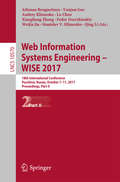- Table View
- List View
Formal Techniques for Distributed Objects, Components, and Systems: 37th IFIP WG 6.1 International Conference, FORTE 2017, Held as Part of the 12th International Federated Conference on Distributed Computing Techniques, DisCoTec 2017, Neuchâtel, Switzerland, June 19-22, 2017, Proceedings (Lecture Notes in Computer Science #10321)
by Ahmed Bouajjani Alexandra SilvaThis book constitutes the proceedings of the 37th IFIP WG 6.1 International Conference on Formal Techniques for Distributed Objects, Components, and Systems, FORTE 2017, held in Neuchâtel, Switzerland, in June 2017, as part of the 12th International Federated Conference on Distributed Computing Techniques, DisCoTec 2017. The 13 revised full papers presented together with 3 short and 1 tool papers were carefully reviewed and selected from 30 submissions. The papers present a wide range of topics on distributed computing models and formal specification, testing, and verification methods.
Biset Functors for Finite Groups (Lecture Notes in Mathematics #1990)
by serge BoucThis volume exposes the theory of biset functors for finite groups, which yields a unified framework for operations of induction, restriction, inflation, deflation and transport by isomorphism. The first part recalls the basics on biset categories and biset functors. The second part is concerned with the Burnside functor and the functor of complex characters, together with semisimplicity issues and an overview of Green biset functors. The last part is devoted to biset functors defined over p-groups for a fixed prime number p. This includes the structure of the functor of rational representations and rational p-biset functors. The last two chapters expose three applications of biset functors to long-standing open problems, in particular the structure of the Dade group of an arbitrary finite p-group.This book is intended both to students and researchers, as it gives a didactic exposition of the basics and a rewriting of advanced results in the area, with some new ideas and proofs.
Green Functors and G-sets (Lecture Notes in Mathematics #1671)
by serge BoucThis book provides a definition of Green functors for a finite group G, and of modules over it, in terms of the category of finite G-sets. Some classical constructions, such as the associated categroy or algebra, have a natural interpretation in that framework. Many notions of ring theory can be extended to Green functors (opposite Green functor, bimodules, Morita theory, simple modules, centres,...). There are moreover connections between Green functors for different groups, given by functors associated to bisets. Intended for researchers and students in representation theory of finite groups it requires only basic algebra and category theory, though knowledge of the classical examples of Mackey functors is probably preferable.
Fundamentals and Advanced Techniques in Derivatives Hedging (Universitext)
by Bruno Bouchard Jean-François ChassagneuxThis book covers the theory of derivatives pricing and hedging as well as techniques used in mathematical finance. The authors use a top-down approach, starting with fundamentals before moving to applications, and present theoretical developments alongside various exercises, providing many examples of practical interest.A large spectrum of concepts and mathematical tools that are usually found in separate monographs are presented here. In addition to the no-arbitrage theory in full generality, this book also explores models and practical hedging and pricing issues. Fundamentals and Advanced Techniques in Derivatives Hedging further introduces advanced methods in probability and analysis, including Malliavin calculus and the theory of viscosity solutions, as well as the recent theory of stochastic targets and its use in risk management, making it the first textbook covering this topic.Graduate students in applied mathematics with an understanding of probability theory and stochastic calculus will find this book useful to gain a deeper understanding of fundamental concepts and methods in mathematical finance.
Asymptotic Methods in Electromagnetics
by Daniel Bouche Frederic Molinet Raj MittraNumerically rigorous techniques for the computation of electromagnetic fields diffracted by an object become computationally intensive, if not impractical to handle, at high frequencies and one must resort to asymptotic methods to solve the scattering problem at short wavelengths. The asymptotic methods provide closed form expansions for the diffracted fields and are also useful for eliciting physical interpretations of the various diffraction phenomena. One of the principal objectives of this book is to discuss the different asymptotic methods in a unified manner. Although the book contains explicit formulas for computing the field diffracted by conducting or dielectric-coated objects, it also provides the mathematical foundations of the different methods and explains how they are interrelated.
Full-stack Development with Angular and Graphql: Build Scalable Modern Web Applications with Cutting-edge Technologies Including Graphql and Angular 12 (PDF)
by Ahmed BouchefraAngular is one of the most popular JavaScript frameworks in modern web app development allowing developers to not only build apps and reuse the code but also develop apps for any deployment target. For web, mobile web, native mobile, and native desktop, GraphQL is the modern and REST alternative for querying web APIs. Using Angular, TypeScript and GraphQL will give you a future-proof and scalable stack you can start building apps around. This book shows you how to build apps using cutting-edge technologies. You'll learn how to solve common web development problems with GraphQL and Apollo, such as database access, authentication, and image uploads. The book starts by introducing you to building full stack apps with Angular and GraphQL. Next, you'll learn how to create a monorepo project with Lerna and NPM Workspaces and configure a Node.js app to use GraphQL with Express and Apollo Server. You'll also understand the basics of Angular architecture and routing. Later, the book demonstrates how to build a professionally-looking UI with Angular Material, use Apollo Client to interface with the server to get data from the built GraphQL API. You'll learn about Apollo Client's type and field policies, and various fetching policies. In addition to this, you'll learn about local state management and reactive variables with Apollo Client and how to generate TypeScript types and even Angular Apollo services for your GraphQL schema and queries using GraphQL Code Generator to implement a scalable codebase. By the end of this book, you'll have the skills you need to be able to build your own full stack application.
Queueing Networks: A Fundamental Approach (International Series in Operations Research & Management Science #154)
by Richard J. Boucherie Nico M. Van DijkThis handbook aims to highlight fundamental, methodological and computational aspects of networks of queues to provide insights and to unify results that can be applied in a more general manner. The handbook is organized into five parts:Part 1 considers exact analytical results such as of product form type. Topics include characterization of product forms by physical balance concepts and simple traffic flow equations, classes of service and queue disciplines that allow a product form, a unified description of product forms for discrete time queueing networks, insights for insensitivity, and aggregation and decomposition results that allow sub networks to be aggregated into single nodes to reduce computational burden.Part 2 looks at monotonicity and comparison results such as for computational simplification by either of two approaches: stochastic monotonicity and ordering results based on the ordering of the process generators, and comparison results and explicit error bounds based on an underlying Markov reward structure leading to ordering of expectations of performance measures.Part 3 presents diffusion and fluid results. It specifically looks at the fluid regime and the diffusion regime. Both of these are illustrated through fluid limits for the analysis of system stability, diffusion approximations for multi-server systems, and a system fed by Gaussian traffic.Part 4 illustrates computational and approximate results through the classical MVA (mean value analysis) and QNA (queueing network analyzer) for computing mean and variance of performance measures such as queue lengths and sojourn times; numerical approximation of response time distributions; and approximate decomposition results for large open queueing networks.Part 5 enlightens selected applications as loss networks originating from circuit switched telecommunications applications, capacity sharing originating from packet switching in data networks, and a hospital application that is of growing present day interest.The book shows that the intertwined progress of theory and practice will remain to be most intriguing and will continue to be the basis of further developments in queueing networks.
Markov Decision Processes in Practice (International Series in Operations Research & Management Science #248)
by Richard J. Boucherie Nico M. van DijkThis book presents classical Markov Decision Processes (MDP) for real-life applications and optimization. MDP allows users to develop and formally support approximate and simple decision rules, and this book showcases state-of-the-art applications in which MDP was key to the solution approach. The book is divided into six parts. Part 1 is devoted to the state-of-the-art theoretical foundation of MDP, including approximate methods such as policy improvement, successive approximation and infinite state spaces as well as an instructive chapter on Approximate Dynamic Programming. It then continues with five parts of specific and non-exhaustive application areas. Part 2 covers MDP healthcare applications, which includes different screening procedures, appointment scheduling, ambulance scheduling and blood management. Part 3 explores MDP modeling within transportation. This ranges from public to private transportation, from airports and traffic lights to car parking or charging your electric car . Part 4 contains three chapters that illustrates the structure of approximate policies for production or manufacturing structures. In Part 5, communications is highlighted as an important application area for MDP. It includes Gittins indices, down-to-earth call centers and wireless sensor networks. Finally Part 6 is dedicated to financial modeling, offering an instructive review to account for financial portfolios and derivatives under proportional transactional costs. The MDP applications in this book illustrate a variety of both standard and non-standard aspects of MDP modeling and its practical use. This book should appeal to readers for practitioning, academic research and educational purposes, with a background in, among others, operations research, mathematics, computer science, and industrial engineering.
Concentration Inequalities: A Nonasymptotic Theory of Independence
by Stéphane Boucheron Gábor Lugosi Pascal MassartConcentration inequalities for functions of independent random variables is an area of probability theory that has witnessed a great revolution in the last few decades, and has applications in a wide variety of areas such as machine learning, statistics, discrete mathematics, and high-dimensional geometry. Roughly speaking, if a function of many independent random variables does not depend too much on any of the variables then it is concentrated in the sense that with high probability, it is close to its expected value. This book offers a host of inequalities to illustrate this rich theory in an accessible way by covering the key developments and applications in the field. The authors describe the interplay between the probabilistic structure (independence) and a variety of tools ranging from functional inequalities to transportation arguments to information theory. Applications to the study of empirical processes, random projections, random matrix theory, and threshold phenomena are also presented. A self-contained introduction to concentration inequalities, it includes a survey of concentration of sums of independent random variables, variance bounds, the entropy method, and the transportation method. Deep connections with isoperimetric problems are revealed whilst special attention is paid to applications to the supremum of empirical processes. Written by leading experts in the field and containing extensive exercise sections this book will be an invaluable resource for researchers and graduate students in mathematics, theoretical computer science, and engineering.
Concentration Inequalities: A Nonasymptotic Theory of Independence
by Stéphane Boucheron Gábor Lugosi Pascal MassartConcentration inequalities for functions of independent random variables is an area of probability theory that has witnessed a great revolution in the last few decades, and has applications in a wide variety of areas such as machine learning, statistics, discrete mathematics, and high-dimensional geometry. Roughly speaking, if a function of many independent random variables does not depend too much on any of the variables then it is concentrated in the sense that with high probability, it is close to its expected value. This book offers a host of inequalities to illustrate this rich theory in an accessible way by covering the key developments and applications in the field. The authors describe the interplay between the probabilistic structure (independence) and a variety of tools ranging from functional inequalities to transportation arguments to information theory. Applications to the study of empirical processes, random projections, random matrix theory, and threshold phenomena are also presented. A self-contained introduction to concentration inequalities, it includes a survey of concentration of sums of independent random variables, variance bounds, the entropy method, and the transportation method. Deep connections with isoperimetric problems are revealed whilst special attention is paid to applications to the supremum of empirical processes. Written by leading experts in the field and containing extensive exercise sections this book will be an invaluable resource for researchers and graduate students in mathematics, theoretical computer science, and engineering.
Information, Uncertainty and Fusion (The Springer International Series in Engineering and Computer Science #516)
by Bernadette Bouchon-Meunier Ronald R. Yager Lotfi ZadehAs we stand at the precipice of the twenty first century the ability to capture and transmit copious amounts of information is clearly a defining feature of the human race. In order to increase the value of this vast supply of information we must develop means for effectively processing it. Newly emerging disciplines such as Information Engineering and Soft Computing are being developed in order to provide the tools required. Conferences such as the International Conference on Information Processing and ManagementofUncertainty in Knowledge-based Systems (IPMU) are being held to provide forums in which researchers can discuss the latest developments. The recent IPMU conference held at La Sorbonne in Paris brought together some of the world's leading experts in uncertainty and information fusion. In this volume we have included a selection ofpapers from this conference. What should be clear from looking at this volume is the number of different ways that are available for representing uncertain information. This variety in representational frameworks is a manifestation of the different types of uncertainty that appear in the information available to the users. Perhaps, the representation with the longest history is probability theory. This representation is best at addressing the uncertainty associated with the occurrence of different values for similar variables. This uncertainty is often described as randomness. Rough sets can be seen as a type of uncertainty that can deal effectively with lack of specificity, it is a powerful tool for manipulating granular information.
Virtual Barrels: Quantitative Trading in the Oil Market (Springer Texts in Business and Economics)
by Ilia BouchouevThe global oil market is no longer solely influenced by the supply and demand of physical oil barrels. In today's landscape, financial barrels traded by hedge funds using quantitative algorithms and dealers managing large portfolios of oil derivatives are equally crucial in determining the price of oil. This book offers a fascinating insight into the world of oil derivatives, exploring the quantitative models and trading strategies used by professional market participants. With a focus on oil options and volatility trading, the reader is taken on a journey through the story of this market, narrated by one of its pioneers who managed a highly successful trading business for almost a quarter of a century. Bridging the fields of energy economics and mathematical finance, this book demonstrates how the science of trading can unearth unique opportunities in the oil market. Written for aspiring quantitative traders and academic researchers alike, it offers a rare glimpse into the opaque and secretive world of oil derivatives, showcasing how it operates in practice.
Implementation and Application of Automata: 16th International Conference, CIAA 2011, Blois, France, July 13-16, 2011, Revised Selected Papers (Lecture Notes in Computer Science #6807)
by Béatrice Bouchou-Markhoff Pascal Caron Jean-Marc Champarnaud Denis MaurelThis book constitutes the thoroughly refereed papers of the 16th International Conference on Implementation and Application of Automata, CIAA 2011, held in Blois, France, in July 2011. The 20 revised full papers together with 4 short papers were carefully selected from 38 submissions. The papers cover various topics such as applications of automata in computer-aided verification; natural language processing; pattern matching, data storage and retrieval; document engineering and bioinformatics as well as foundational work on automata theory.
IGA: Non-conforming Coupling and Shape Optimization of Complex Multipatch Structures
by Robin Bouclier Thibaut HirschlerIsogeometric analysis (IGA) consists of using the same higher-order and smooth spline functions for the representation of geometry in Computer Aided Design as for the approximation of solution fields in Finite Element Analysis. Now, about fifteen years after its creation, substantial works are being reported in IGA, which make it very competitive in scientific computing.This book provides a contemporary vision of IGA by first discussing the current challenges in achieving a true bridge between design and analysis, then proposing original solutions that answer the issues from an analytical point of view, and, eventually, studying the shape optimization of structures, which is one of the greatest applications of IGA. To handle complex structures, a full analysis-to-optimization framework is developed, based on non-invasive coupling, parallel domain decomposition and immersed geometrical modeling. This seems to be very robust, taking on all of the attractive features of IGA (the design–analysis link, numerical efficiency and natural regularization), giving us the opportunity to explore new types of design.
IGA: Non-Invasive Coupling with FEM and Regularization of Digital Image Correlation Problems, Volume 2
by Robin Bouclier Jean-Charles PassieuxIsogeometric analysis (IGA) consists of using the same higher-order and smooth spline functions for the representation of geometry in Computer Aided Design as for the approximation of solution fields in Finite Element Analysis. Now, almost twenty years after its creation, substantial works are being reported in IGA, making it very competitive in scientific computing. This book proposes to use IGA jointly with standard finite element methods (FEM), presenting IGA as a projection of FEM on a more regular reduced basis. By shedding new light on how IGA relates to FEM, we can see how IGA can be implemented on top of an FE code in order to improve the solution of problems that require more regularity. This is illustrated by using IGA with FEM in a non-invasive fashion to perform efficient and robust multiscale global/local simulations in solid mechanics. Furthermore, we show that IGA can regularize the inverse problem of FE digital image correlation in experimental mechanics.
IGA: Non-Invasive Coupling with FEM and Regularization of Digital Image Correlation Problems, Volume 2
by Robin Bouclier Jean-Charles PassieuxIsogeometric analysis (IGA) consists of using the same higher-order and smooth spline functions for the representation of geometry in Computer Aided Design as for the approximation of solution fields in Finite Element Analysis. Now, almost twenty years after its creation, substantial works are being reported in IGA, making it very competitive in scientific computing. This book proposes to use IGA jointly with standard finite element methods (FEM), presenting IGA as a projection of FEM on a more regular reduced basis. By shedding new light on how IGA relates to FEM, we can see how IGA can be implemented on top of an FE code in order to improve the solution of problems that require more regularity. This is illustrated by using IGA with FEM in a non-invasive fashion to perform efficient and robust multiscale global/local simulations in solid mechanics. Furthermore, we show that IGA can regularize the inverse problem of FE digital image correlation in experimental mechanics.
Quantum Mechanics in the Geometry of Space-Time: Elementary Theory (SpringerBriefs in Physics)
by Roger BoudetThis book continues the fundamental work of Arnold Sommerfeld and David Hestenes formulating theoretical physics in terms of Minkowski space-time geometry. We see how the standard matrix version of the Dirac equation can be reformulated in terms of a real space-time algebra, thus revealing a geometric meaning for the “number i” in quantum mechanics. Next, it is examined in some detail how electroweak theory can be integrated into the Dirac theory and this way interpreted in terms of space-time geometry. Finally, some implications for quantum electrodynamics are considered. The presentation of real quantum electromagnetism is expressed in an addendum. The book covers both the use of the complex and the real languages and allows the reader acquainted with the first language to make a step by step translation to the second one.
Applied Computational Physics
by Joseph F. Boudreau Eric S. SwansonApplied Computational Physics is a graduate-level text stressing three essential elements: advanced programming techniques, numerical analysis, and physics. The goal of the text is to provide students with essential computational skills that they will need in their careers, and to increase the confidence with which they write computer programs designed for their problem domain. The physics problems give them an opportunity to reinforce their programming skills, while the acquired programming skills augment their ability to solve physics problems. The C++ language is used throughout the text. Physics problems include Hamiltonian systems, chaotic systems, percolation, critical phenomena, few-body and multi-body quantum systems, quantum field theory, simulation of radiation transport, and data modeling. The book, the fruit of a collaboration between a theoretical physicist and an experimental physicist, covers a broad range of topics from both viewpoints. Examples, program libraries, and additional documentation can be found at the companion website. Hundreds of original problems reinforce programming skills and increase the ability to solve real-life physics problems at and beyond the graduate level.
Actuarial Finance: Derivatives, Quantitative Models and Risk Management
by Mathieu Boudreault Jean-François RenaudA new textbook offering a comprehensive introduction to models and techniques for the emerging field of actuarial Finance Drs. Boudreault and Renaud answer the need for a clear, application-oriented guide to the growing field of actuarial finance with this volume, which focuses on the mathematical models and techniques used in actuarial finance for the pricing and hedging of actuarial liabilities exposed to financial markets and other contingencies. With roots in modern financial mathematics, actuarial finance presents unique challenges due to the long-term nature of insurance liabilities, the presence of mortality or other contingencies and the structure and regulations of the insurance and pension markets. Motivated, designed and written for and by actuaries, this book puts actuarial applications at the forefront in addition to balancing mathematics and finance at an adequate level to actuarial undergraduates. While the classical theory of financial mathematics is discussed, the authors provide a thorough grounding in such crucial topics as recognizing embedded options in actuarial liabilities, adequately quantifying and pricing liabilities, and using derivatives and other assets to manage actuarial and financial risks. Actuarial applications are emphasized and illustrated with about 300 examples and 200 exercises. The book also comprises end-of-chapter point-form summaries to help the reader review the most important concepts. Additional topics and features include: Compares pricing in insurance and financial markets Discusses event-triggered derivatives such as weather, catastrophe and longevity derivatives and how they can be used for risk management; Introduces equity-linked insurance and annuities (EIAs, VAs), relates them to common derivatives and how to manage mortality for these products Introduces pricing and replication in incomplete markets and analyze the impact of market incompleteness on insurance and risk management; Presents immunization techniques alongside Greeks-based hedging; Covers in detail how to delta-gamma/rho/vega hedge a liability and how to rebalance periodically a hedging portfolio. This text will prove itself a firm foundation for undergraduate courses in financial mathematics or economics, actuarial mathematics or derivative markets. It is also highly applicable to current and future actuaries preparing for the exams or actuary professionals looking for a valuable addition to their reference shelf. As of 2019, the book covers significant parts of the Society of Actuaries’ Exams FM, IFM and QFI Core, and the Casualty Actuarial Society’s Exams 2 and 3F. It is assumed the reader has basic skills in calculus (differentiation and integration of functions), probability (at the level of the Society of Actuaries’ Exam P), interest theory (time value of money) and, ideally, a basic understanding of elementary stochastic processes such as random walks.
Actuarial Finance: Derivatives, Quantitative Models and Risk Management
by Mathieu Boudreault Jean-François RenaudA new textbook offering a comprehensive introduction to models and techniques for the emerging field of actuarial Finance Drs. Boudreault and Renaud answer the need for a clear, application-oriented guide to the growing field of actuarial finance with this volume, which focuses on the mathematical models and techniques used in actuarial finance for the pricing and hedging of actuarial liabilities exposed to financial markets and other contingencies. With roots in modern financial mathematics, actuarial finance presents unique challenges due to the long-term nature of insurance liabilities, the presence of mortality or other contingencies and the structure and regulations of the insurance and pension markets. Motivated, designed and written for and by actuaries, this book puts actuarial applications at the forefront in addition to balancing mathematics and finance at an adequate level to actuarial undergraduates. While the classical theory of financial mathematics is discussed, the authors provide a thorough grounding in such crucial topics as recognizing embedded options in actuarial liabilities, adequately quantifying and pricing liabilities, and using derivatives and other assets to manage actuarial and financial risks. Actuarial applications are emphasized and illustrated with about 300 examples and 200 exercises. The book also comprises end-of-chapter point-form summaries to help the reader review the most important concepts. Additional topics and features include: Compares pricing in insurance and financial markets Discusses event-triggered derivatives such as weather, catastrophe and longevity derivatives and how they can be used for risk management; Introduces equity-linked insurance and annuities (EIAs, VAs), relates them to common derivatives and how to manage mortality for these products Introduces pricing and replication in incomplete markets and analyze the impact of market incompleteness on insurance and risk management; Presents immunization techniques alongside Greeks-based hedging; Covers in detail how to delta-gamma/rho/vega hedge a liability and how to rebalance periodically a hedging portfolio. This text will prove itself a firm foundation for undergraduate courses in financial mathematics or economics, actuarial mathematics or derivative markets. It is also highly applicable to current and future actuaries preparing for the exams or actuary professionals looking for a valuable addition to their reference shelf. As of 2019, the book covers significant parts of the Society of Actuaries’ Exams FM, IFM and QFI Core, and the Casualty Actuarial Society’s Exams 2 and 3F. It is assumed the reader has basic skills in calculus (differentiation and integration of functions), probability (at the level of the Society of Actuaries’ Exam P), interest theory (time value of money) and, ideally, a basic understanding of elementary stochastic processes such as random walks.
Design and Control of Swarm Dynamics (SpringerBriefs in Complexity)
by Roland BouffanaisThe book is about the key elements required for designing, building and controlling effective artificial swarms comprised of multiple moving physical agents. Therefore this book presents the fundamentals of each of those key elements in the particular frame of dynamic swarming, specifically exposing the profound connections between these elements and establish some general design principles for swarming behaviors. This scientific endeavor requires an inter-disciplinary approach: biomimetic inspiration from ethology and ecology, study of social information flow, analysis of temporal and adaptive signaling network of interaction, considerations of control of networked real-time systems, and lastly, elements of complex adaptive dynamical systems. This book offers a completely new perspective on the scientific understanding of dynamic collective behaviors thanks to its multi-disciplinary approach and its focus on artificial swarm of physical agents. Two of the key problems in understanding the emergence of swarm intelligent behaviors are identifying the social interaction rules a.k.a. the behavioral algorithm and uncovering how information flows between swarming agents. While most books about swarm dynamics have been focusing on the former, this book emphasizes the much-less discussed topic of distributed information flow, always with the aim of establishing general design principles.
Iwasawa Theory 2012: State of the Art and Recent Advances (Contributions in Mathematical and Computational Sciences #7)
by Thanasis Bouganis Otmar VenjakobThis is the fifth conference in a bi-annual series, following conferences in Besancon, Limoges, Irsee and Toronto. The meeting aims to bring together different strands of research in and closely related to the area of Iwasawa theory. During the week before the conference in a kind of summer school a series of preparatory lectures for young mathematicians was provided as an introduction to Iwasawa theory.Iwasawa theory is a modern and powerful branch of number theory and can be traced back to the Japanese mathematician Kenkichi Iwasawa, who introduced the systematic study of Z_p-extensions and p-adic L-functions, concentrating on the case of ideal class groups. Later this would be generalized to elliptic curves. Over the last few decades considerable progress has been made in automorphic Iwasawa theory, e.g. the proof of the Main Conjecture for GL(2) by Kato and Skinner & Urban. Techniques such as Hida’s theory of p-adic modular forms and big Galois representations play a crucial part. Also a noncommutative Iwasawa theory of arbitrary p-adic Lie extensions has been developed. This volume aims to present a snapshot of the state of art of Iwasawa theory as of 2012. In particular it offers an introduction to Iwasawa theory (based on a preparatory course by Chris Wuthrich) and a survey of the proof of Skinner & Urban (based on a lecture course by Xin Wan).
Products of Random Matrices with Applications to Schrödinger Operators (Progress in Probability #8)
by P. Bougerol LacroixCHAPTER I THE DETERMINISTIC SCHRODINGER OPERATOR 187 1. The difference equation. Hyperbolic structures 187 2. Self adjointness of H. Spectral properties . 190 3. Slowly increasing generalized eigenfunctions 195 4. Approximations of the spectral measure 196 200 5. The pure point spectrum. A criterion 6. Singularity of the spectrum 202 CHAPTER II ERGODIC SCHRÖDINGER OPERATORS 205 1. Definition and examples 205 2. General spectral properties 206 3. The Lyapunov exponent in the general ergodie case 209 4. The Lyapunov exponent in the independent eas e 211 5. Absence of absolutely continuous spectrum 221 224 6. Distribution of states. Thouless formula 232 7. The pure point spectrum. Kotani's criterion 8. Asymptotic properties of the conductance in 234 the disordered wire CHAPTER III THE PURE POINT SPECTRUM 237 238 1. The pure point spectrum. First proof 240 2. The Laplace transform on SI(2,JR) 247 3. The pure point spectrum. Second proof 250 4. The density of states CHAPTER IV SCHRÖDINGER OPERATORS IN A STRIP 2';3 1. The deterministic Schrödinger operator in 253 a strip 259 2. Ergodie Schrödinger operators in a strip 3. Lyapunov exponents in the independent case. 262 The pure point spectrum (first proof) 267 4. The Laplace transform on Sp(~,JR) 272 5. The pure point spectrum, second proof vii APPENDIX 275 BIBLIOGRAPHY 277 viii PREFACE This book presents two elosely related series of leetures. Part A, due to P.
Interconnecting Heterogeneous Information Systems (Advances in Database Systems #14)
by Athman Bouguettaya Boualem Benatallah Ahmed K. ElmagarmidInformation systems are the backbone of many of today's computerized applications. Distributed databases and the infrastructure needed to support them have been well studied. However, this book is the first to address distributed database interoperability by examining the successes and failures, various approaches, infrastructures, and trends of the field. A gap exists in the way that these systems have been investigated by real practitioners. This gap is more pronounced than usual, partly because of the way businesses operate, the systems they have, and the difficulties created by systems' autonomy and heterogeneity. Telecommunications firms, for example, must deal with an increased demand for automation while at the same time continuing to function at their current level. While academics are focusing on investigating differences between distributed databases, federated databases, heterogeneous databases, and, more generally, among loosely connected and tightly coupled systems, those who have to deal with real problems right away know that the only relevant research is the one that will ensure that their system works to produce reasonably correct results. Interconnecting Heterogeneous Information Systems covers the underlying principles and infrastructures needed to realize truly global information systems. The book discusses technologies related to middleware, the Web, workflows, transactions, and data warehousing. It also overviews architectures with a discussion of critical issues. The book gives an overview of systems that can be viewed as learning platforms. While these systems do not translate to successful commercial realities, they push the envelope in terms of research. Successful commercial systems have benefited from the experiments conducted in these prototypes. The book includes two case studies based on the authors' own work. Interconnecting Heterogeneous Information Systems is suitable as a textbook for a graduate-level course on Interconnecting Heterogeneous Information Systems, as well as a secondary text for a graduate-level course on database or information systems, and as a reference for researchers and practitioners in industry.
Web Information Systems Engineering – WISE 2017: 18th International Conference, Puschino, Russia, October 7-11, 2017, Proceedings, Part II (Lecture Notes in Computer Science #10570)
by Athman Bouguettaya Yunjun Gao Andrey Klimenko Lu Chen Xiangliang Zhang Fedor Dzerzhinskiy Weijia Jia Stanislav V. Klimenko Qing LiThe two-volume set LNCS 10569 and LNCS 10570 constitutes the proceedings of the 18th International Conference on Web Information Systems Engineering, WISE 2017, held in Puschino, Russia, in October 2017. The 49 full papers and 24 short papers presented were carefully reviewed and selected from 195 submissions. The papers cover a wide range of topics such as microblog data analysis, social network data analysis, data mining, pattern mining, event detection, cloud computing, query processing, spatial and temporal data, graph theory, crowdsourcing and crowdsensing, web data model, language processing and web protocols, web-based applications, data storage and generator, security and privacy, sentiment analysis, and recommender systems.
